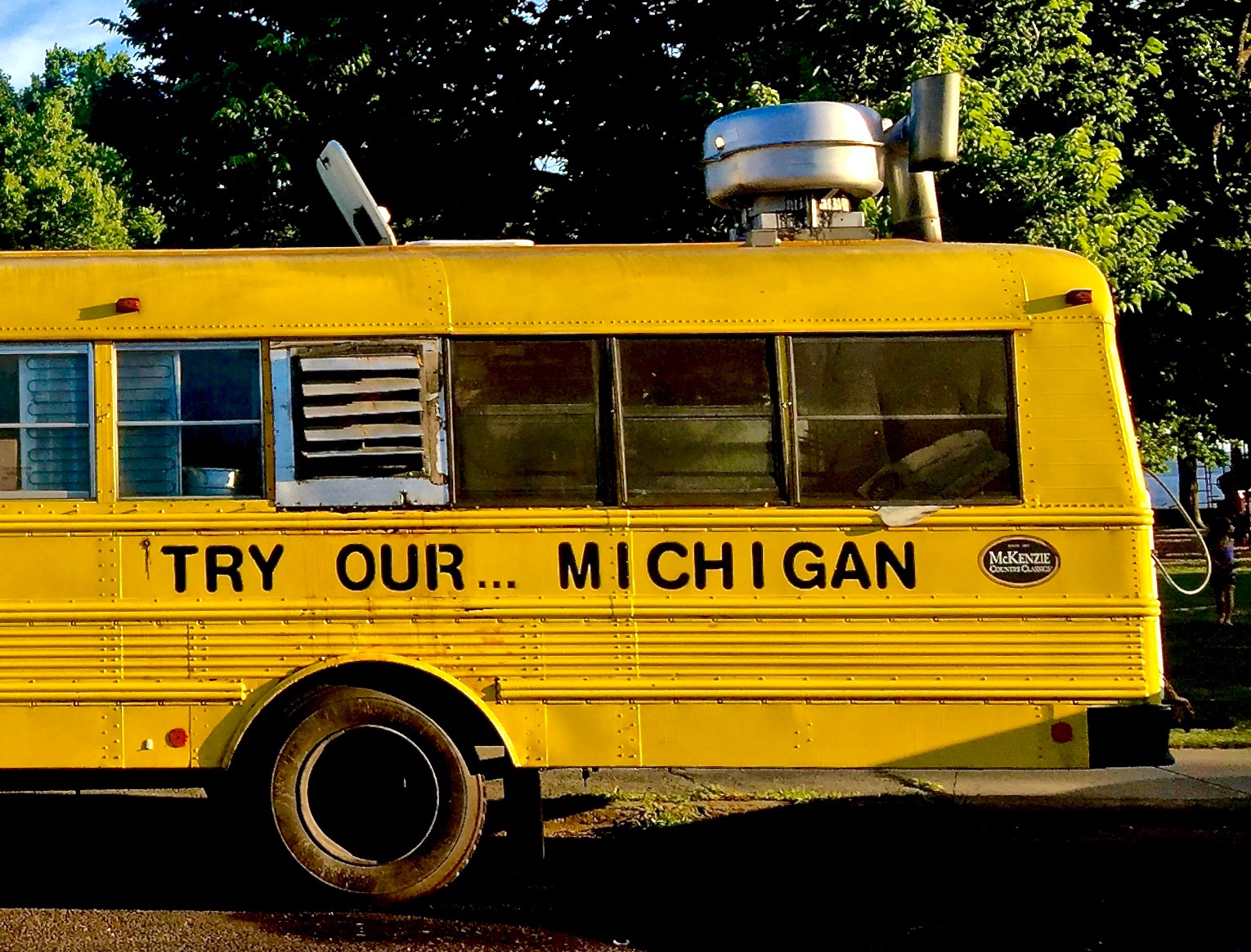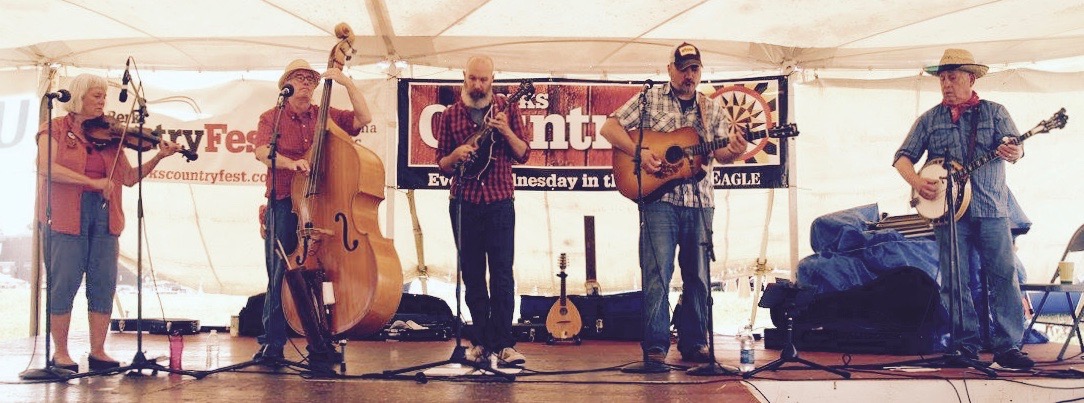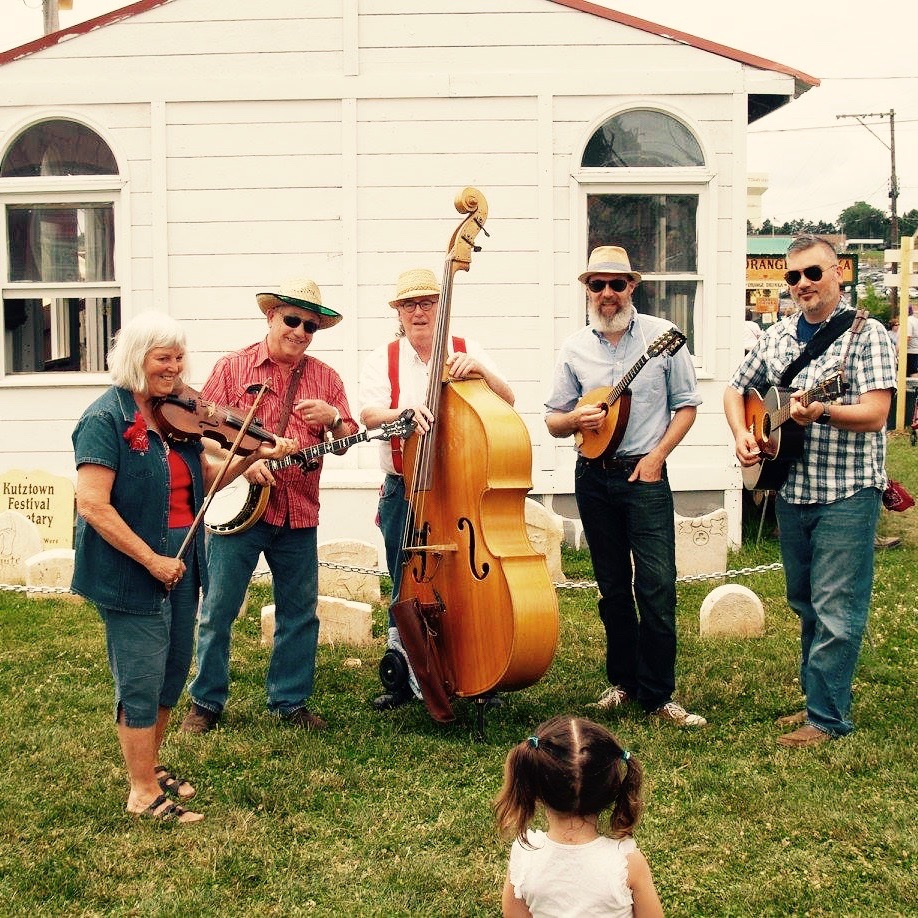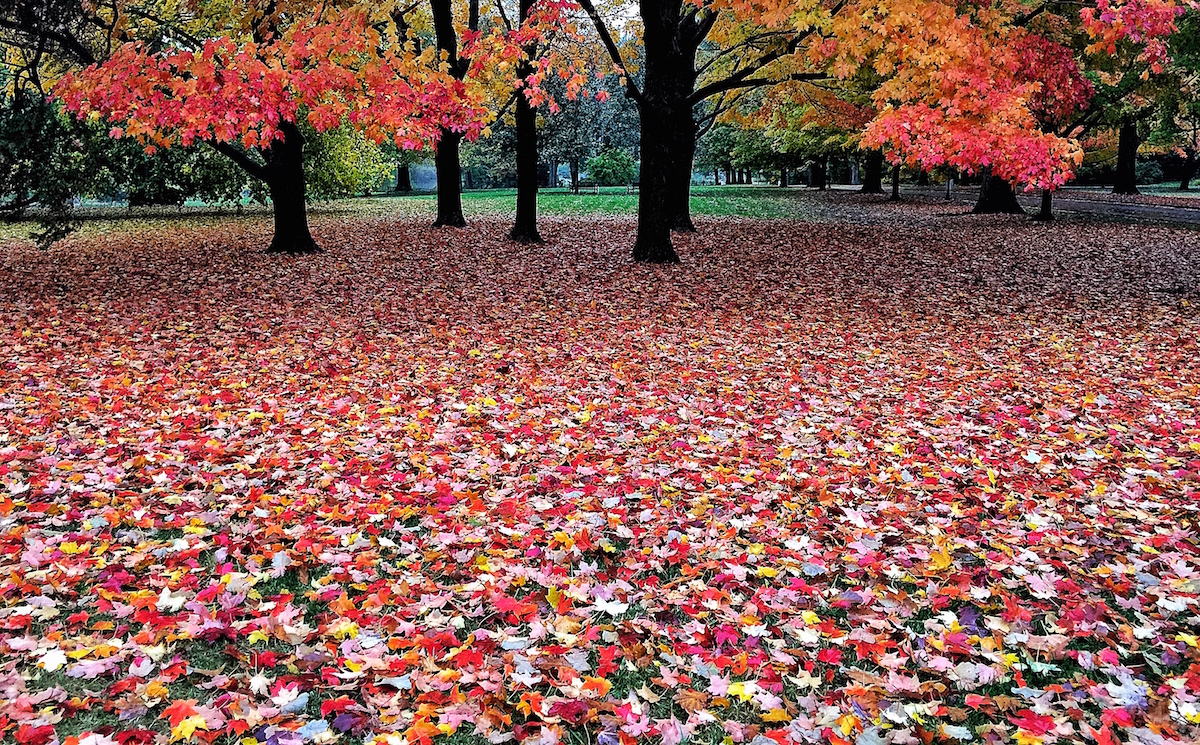Hacking a Tom Bihn Field Journal Notebook for a 9.7" iPad
Tom Bihn makes some really nice travel bags, backpacks, and briefcase/messenger-style bags. I previously wrote about their Large Cafe Bag and taking my Aeronaut 45 to New Zealand and Australia, and have always thought their Field Journal Notebook was groovy. But I've gone almost completely digital and don't need to carry around paper, pencils, and pens anymore. What I do carry with me almost everywhere is an iPad, and I currently have the 9.7" iPad Pro, with the Smart Keyboard cover. As I've come to use the iPad more and more, and a laptop less and less, I realized that what I really could use was a case/bag that was just big enough to for the iPad, my phone, wallet, keys, and few other little odds and ends. Essentially, rather than taking a laptop with me, much of what I need (for meetings, email, surfing) could be contained in a super-small minimalist bag.
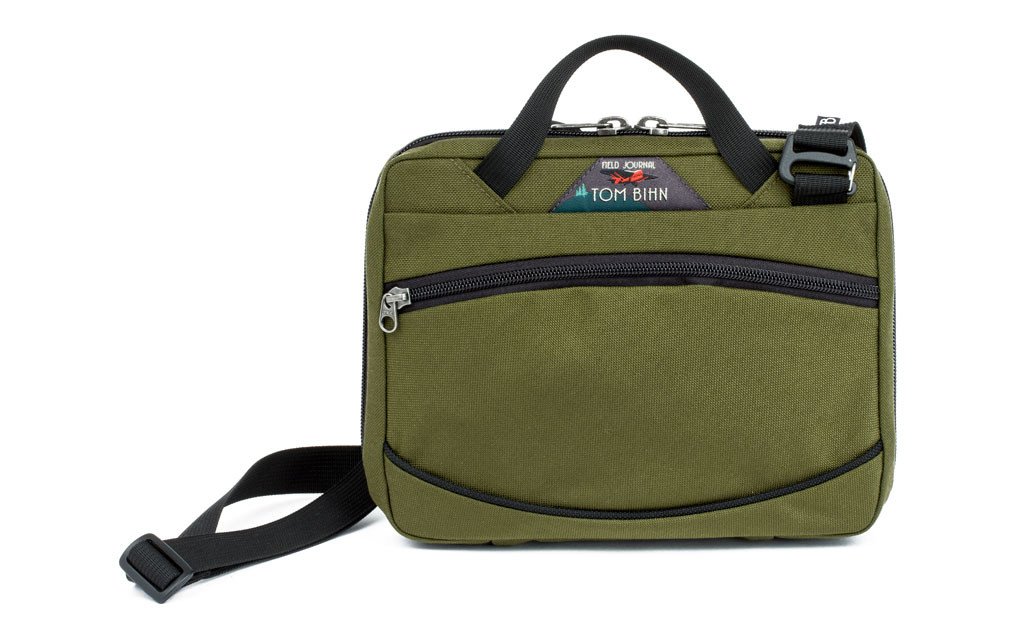
This is where the Field Journal Notebook (FJN) came back into play. I've seen threads on the Tom Bihn forums where people have put their iPad Minis in their FJN (see here and here), but if you look at the dimensions of the FJN, it's just a shade larger than a regular iPad. One of the threads showed that an iPad Air would fit in a FJN that had been "gutted", with the 3-ring binder and paper removed, and I realized that this actually fits my needs perfectly. I don't need the paper, but I do want to carry an iPad (9.7" version).
So I ordered a FJN, and confirmed that once the binder is removed, a 9.7" iPad Pro with a Smart Keyboard will fit. But if you remove the binder, the FJN loses some of it's rigidity and also the back panel is exposed (i.e., it's not "finished" to be an exposed surface. It would be great to retain the plastic backing without the binder rings. I'd just need to find some flexible, yet still relatively stiff, plastic that could be cut to size. A trip to my local Bed Bath and Beyond yielded the perfect solution: a plastic cutting board, sold in a package of four for $8 (after a 20% BBB coupon).
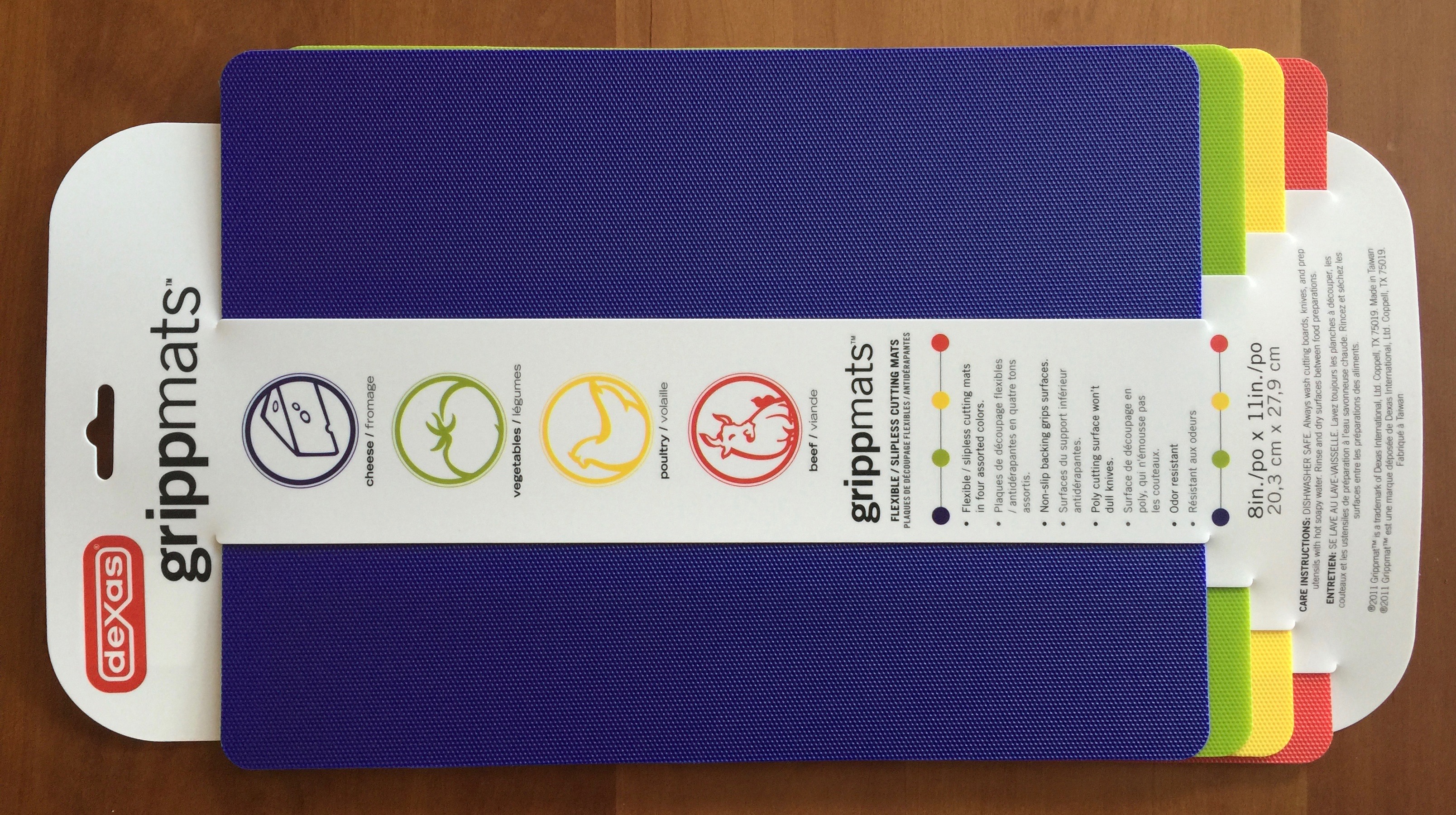
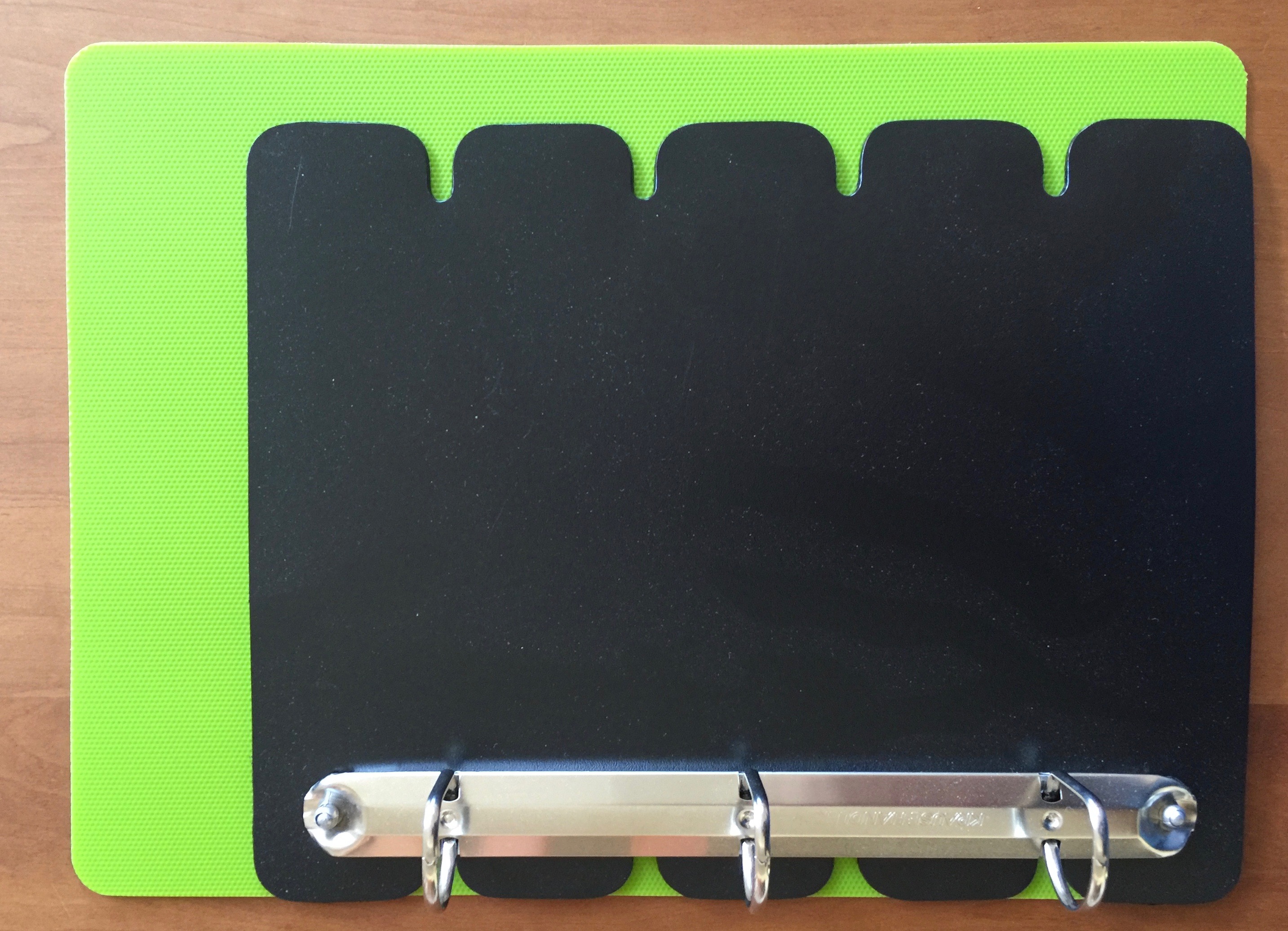
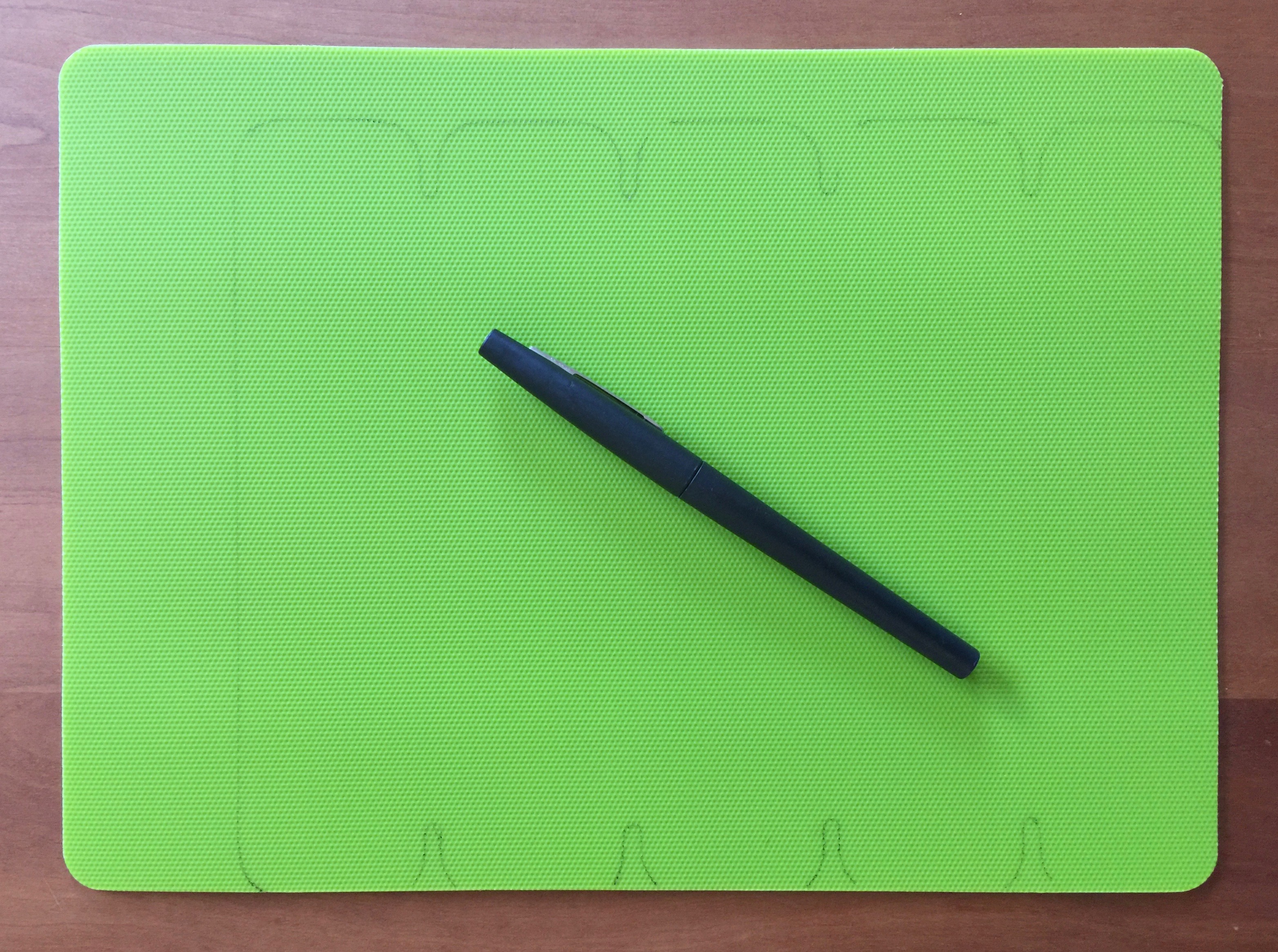
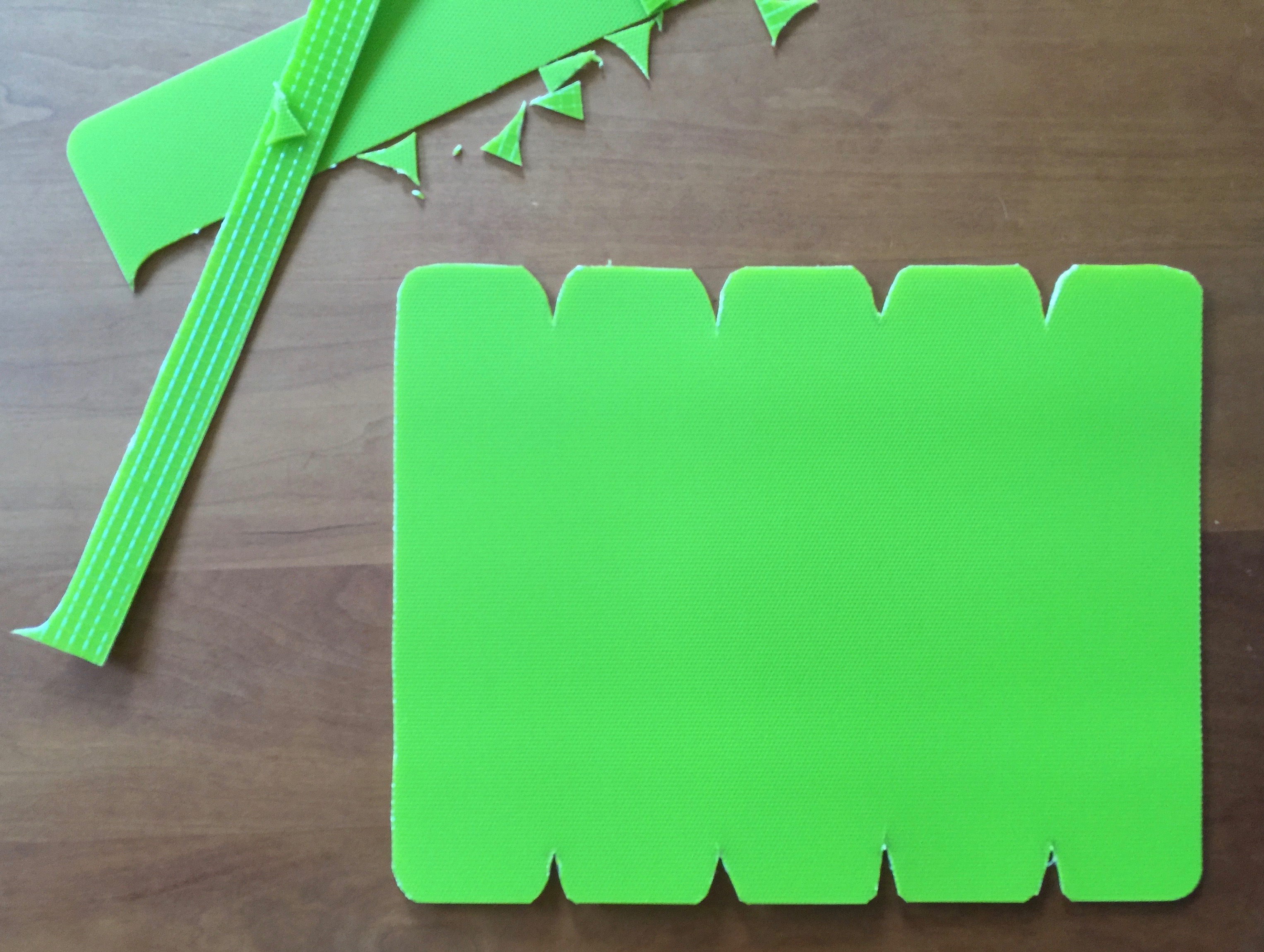

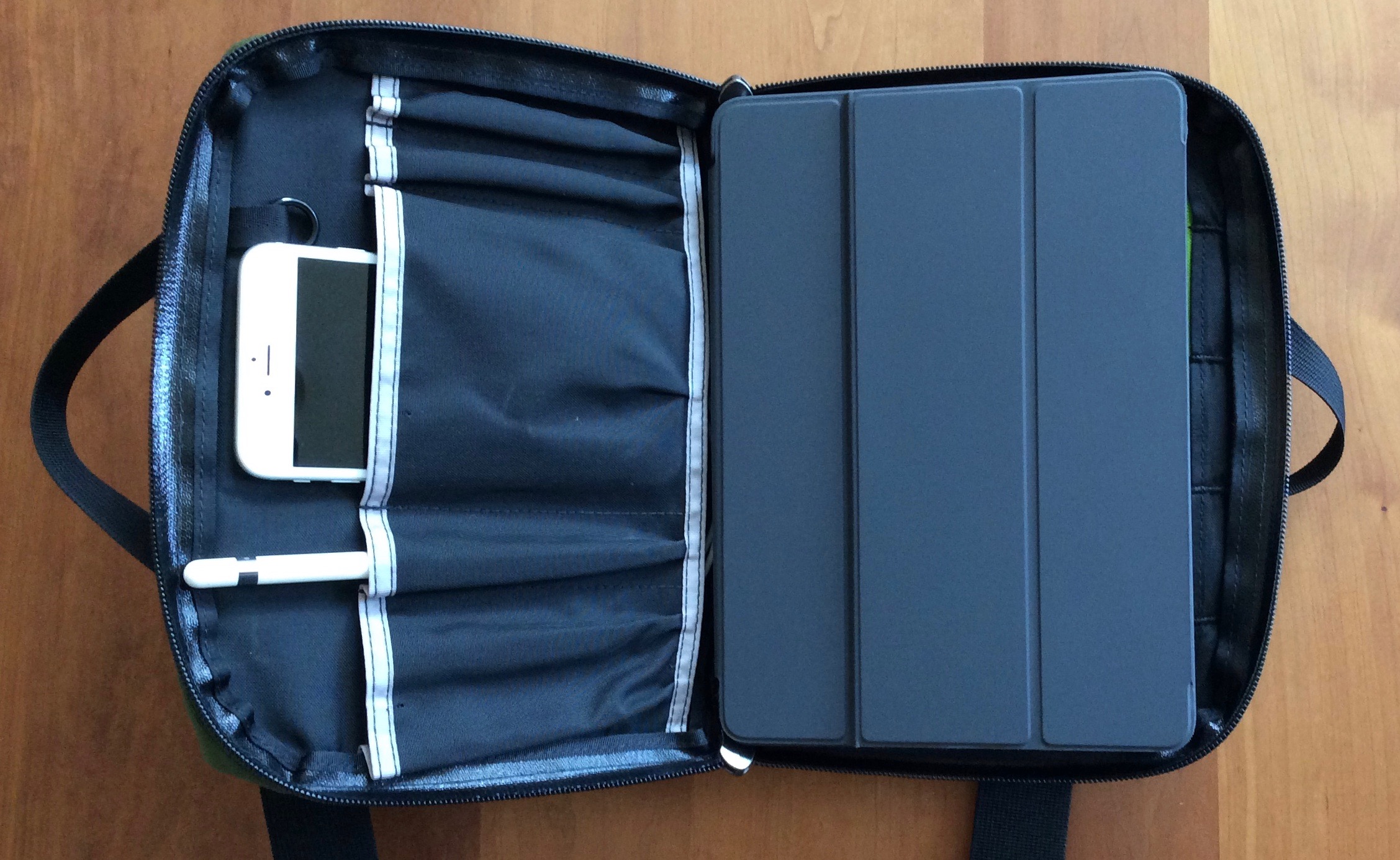
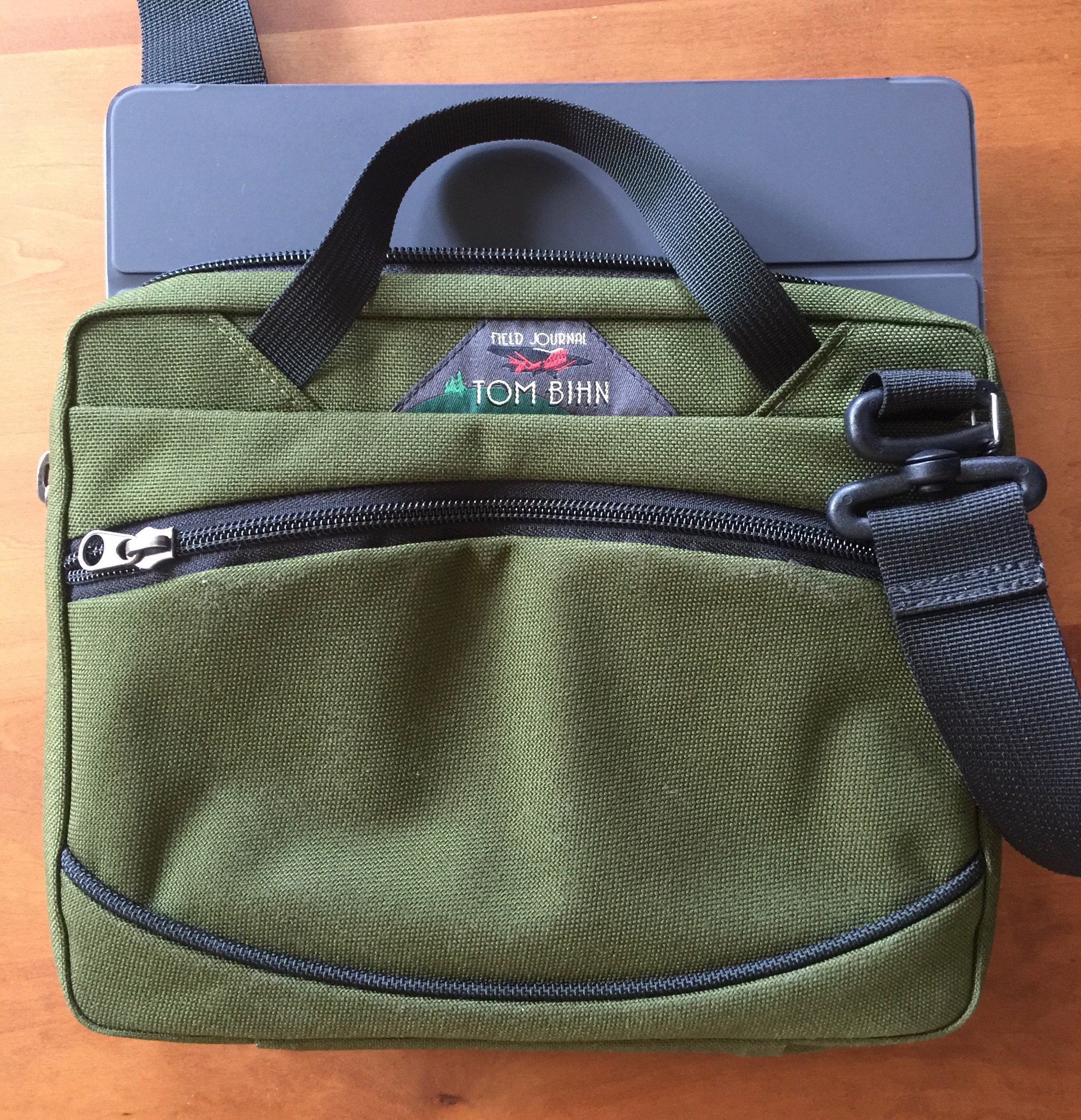
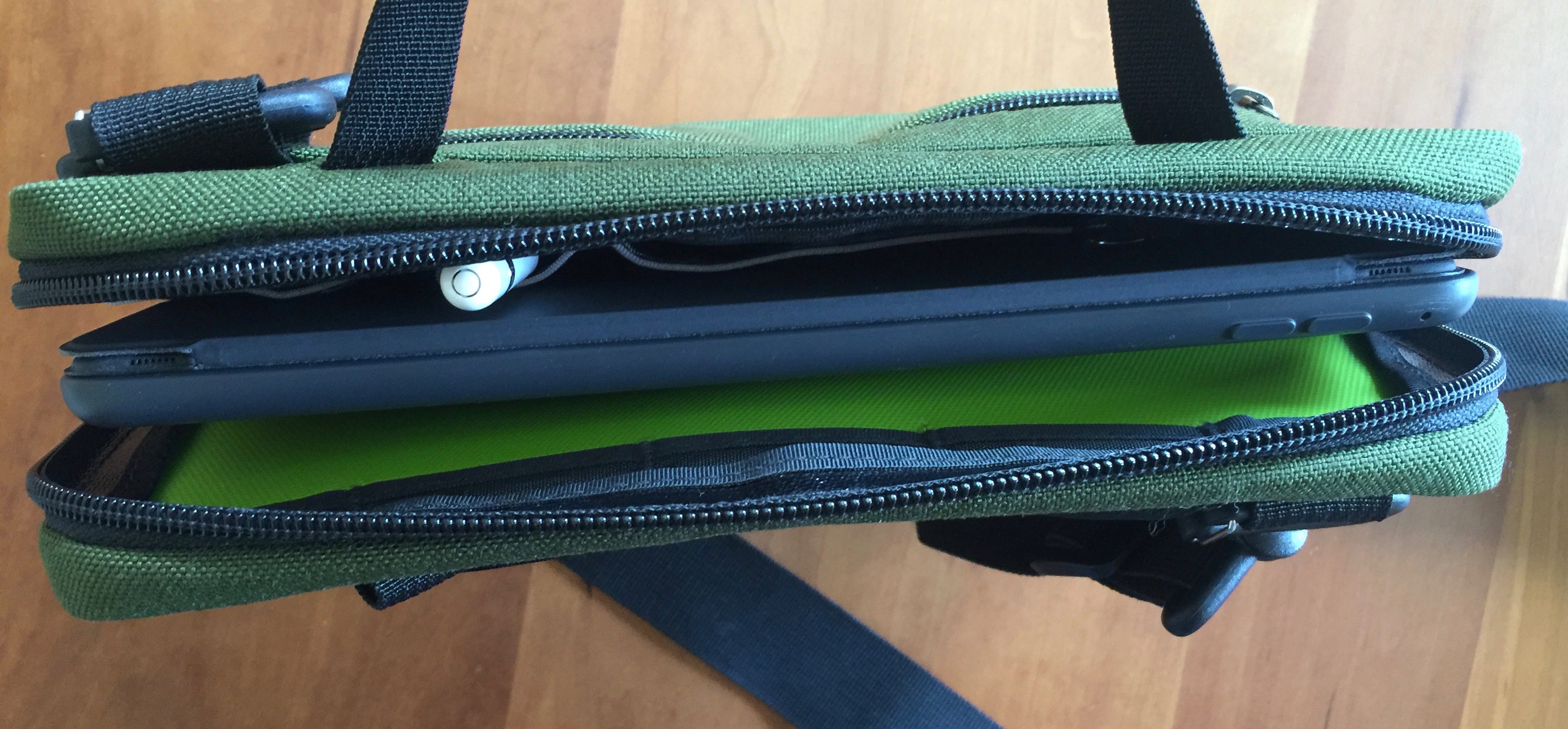
I also removed the seams between a couple of the pencil/phone slots, so that an iPhone 6 Plus would fit, as well as a small lipstick-sized USB battery. In addiion, you might notice that this strap is a bit wider than the one that comes with the FJN; this one came from another laptop bag I had laying around the house.
Photo of the week - August 9, 2016
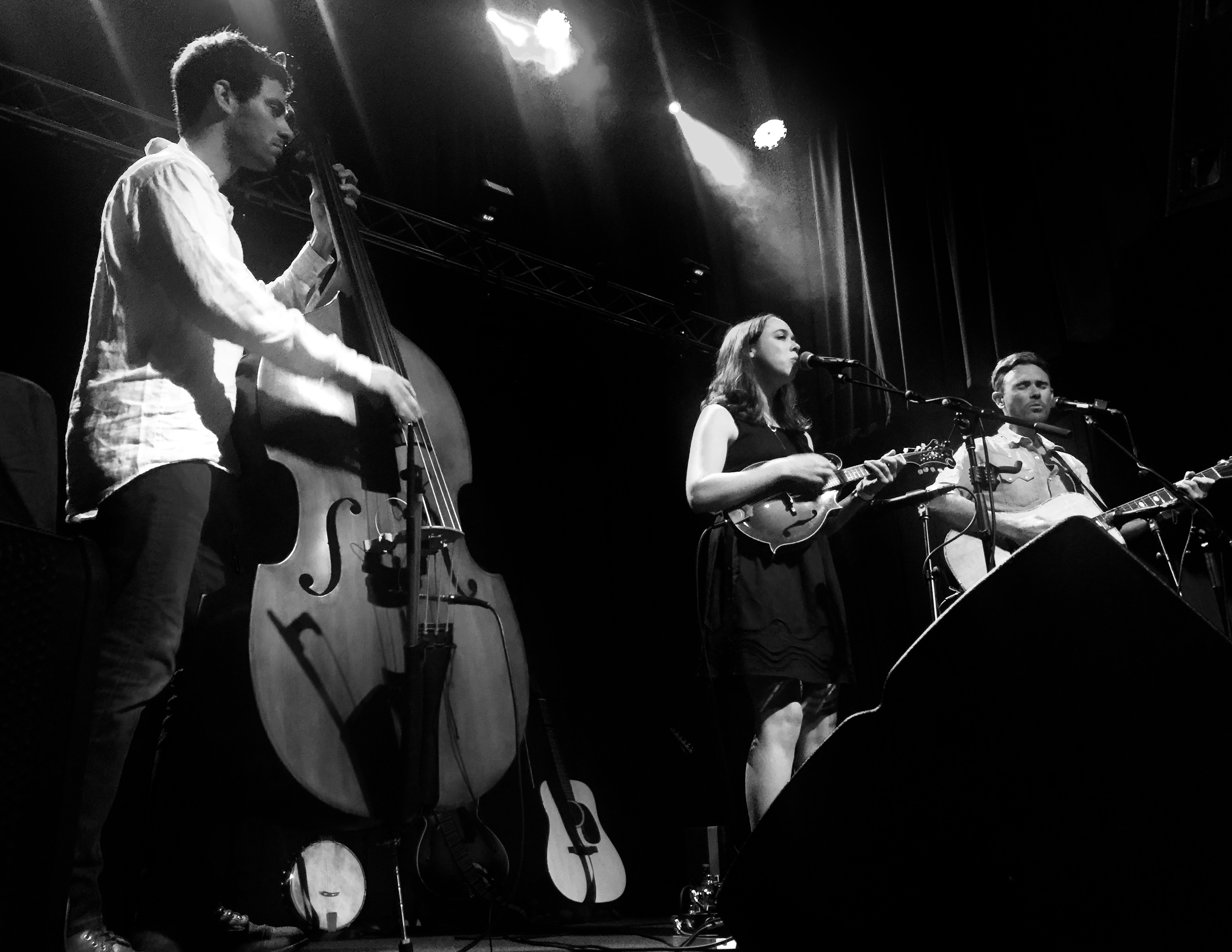
Sarah Jarosz and band at the Ardmore Music Hall, July 31 2016.
 Tuesday, August 9, 2016 |
Tuesday, August 9, 2016 |  Post a Comment in
Post a Comment in  photo of the week | tagged
photo of the week | tagged  ardmore music hall,
ardmore music hall,  concert,
concert,  iphone,
iphone,  sarah jarosz
sarah jarosz Tuning up
I got a new gadget in the mail today: a Keyer Quick-Clip tuner. It's an interesting concept that uses a little magnet to attach a small tuner to the back of a standard (and commonly used) Kyser Quick-Change capo.
Advantages: Since the tuner is on the capo, and a lot of people already clamp a Kyser to their headstock, it's one less thing clip onto your guitar. I also like that the tuner attaches/detaches easily. Maybe I'll just keep the tuner in my pocket and quickly (magnetically) snap it on when needed.
Disadvantages: You have to use a Kyser capo, although begrudgingly I already sometimes use one (rather than my preferred Elliott/McKinney or Shubb Finetune capos) when gigging, for faster changes.
Someone needs to hack an Elliott or Shubb Fine Tune so that a small tuner can attach magnetically to the back of their respective adjustment knobs.
Update: Here's a similar idea...a tuner that magnetically sticks to the back of a metal tuning machine. This as also an interesting concept, although (a) the tuner doesn't look as good as others and (b) it doesn't look like it would work for open-geared tuners like Waverlys.

BTW, my favorite tuner is the TC Polytune Clip, although I'd like it even better if it artculated in two dimensions rather than just one.
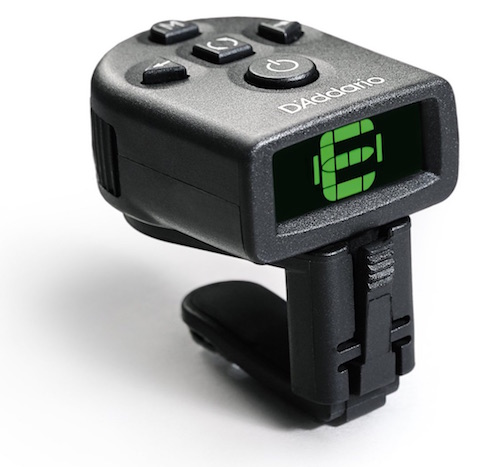 I also like the D'Addario NS Micro Tuner due to its small size and that it can be (relatively unobstrusively) clipped to the back of a headstock. They are also inexpensive (~$12 each, or ~$17 for a 2-pack), so I don't worry about losing/breaking them. Although it's wasteful, I almost think of them as disposable.
I also like the D'Addario NS Micro Tuner due to its small size and that it can be (relatively unobstrusively) clipped to the back of a headstock. They are also inexpensive (~$12 each, or ~$17 for a 2-pack), so I don't worry about losing/breaking them. Although it's wasteful, I almost think of them as disposable.
 Monday, July 18, 2016 |
Monday, July 18, 2016 |  Post a Comment | tagged
Post a Comment | tagged  d'addario,
d'addario,  guitar,
guitar,  guitar gear,
guitar gear,  kyser,
kyser,  tc electronics,
tc electronics,  tuners
tuners These are a few of my favorite strings
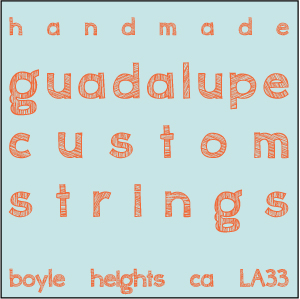 For years I played Martin Marquis 80/20s, although I'm not against trying different strings (see here for my thoughts on Martin Monels; a.k.a. Retros) and have been playing D'Addario EJ12s recently.
For years I played Martin Marquis 80/20s, although I'm not against trying different strings (see here for my thoughts on Martin Monels; a.k.a. Retros) and have been playing D'Addario EJ12s recently.
A few months ago picked up a few sets of strings made by the Guadalupe Custom Strings (update 8/13/18: now The Gabriel Tenorio String Company); these are handmade strings, wound on a round core rather than hex-core, and at $18 a set they weren't cheap. GCS makes all sorts of cool strings for various instruments, and I liked their guitar strings a lot. And I like supporting artisans who produce unique products. But last I checked they were up to $25 a set in the gauge(s) I prefer, which is more than I want to spend. So I just picked up a stack of DR Sunbeams, which are also round core strings available at about $7 a set. We'll see if these stick for a while.
 Sunday, July 17, 2016 |
Sunday, July 17, 2016 |  Post a Comment | tagged
Post a Comment | tagged  d'addario,
d'addario,  dr strings,
dr strings,  guadalupe custom strings,
guadalupe custom strings,  guitar,
guitar,  martin,
martin,  strings
strings What I'm GAS-ing for, summer 2016 edition
Every couple of years I get the urge to make a list of guitars I want (see fall 2012 and fall 2014 editions). I've been playing with a gigging bluegrass band since the start of the year, so I've been playing a lot more guitar and less lap slide, banjo, mandolin etc., and am on the lookout for interesting guitars to expand my tonal palette.
- The Paul Beard A Model Odessey (a round-neck resonator). How cool are these?
- A gyspy jazz guitar. I'm still on the fence about it being an oval- or D-hole, although I do think the D-holes look cooler. Right now the leading contenders are instruments by DuPont and Shelley Park.
- A Waterloo Jumbo King. More Waterloo mojo, in a bigger package.
- A Bourgeois BK. Done! Our NSF grant was funded, so I got summer salary for the first time :-)
- A baritone lap slide; either a Weissenborn-style or Tricone. Something with a 27-28" scale that is tuned to open C (or B?).
- A late 40s to mid-50's Martin D-28. A '53 with a "mystery spruce" top would be perfect. An early D-21 would also fit the bill (1955-1957ish). Done! 1956 D-21. But then I remind myself that I almost always prefer mahogany guitars to rosewood.
- One of the new Collings Traditional dreadnoughts, especially with a Sitka spruce top (since my Collings D1A has red spruce). These look sweet.

 Tuesday, February 23, 2016 |
Tuesday, February 23, 2016 |  Post a Comment in
Post a Comment in  photo of the week | tagged
photo of the week | tagged  55-200mm,
55-200mm,  fuji x-pro1,
fuji x-pro1,  gorilla,
gorilla,  san diego zoo
san diego zoo  Tuesday, February 16, 2016 |
Tuesday, February 16, 2016 |  Post a Comment in
Post a Comment in  photo of the week | tagged
photo of the week | tagged  55-200mm,
55-200mm,  fuji x-pro1,
fuji x-pro1,  orangutan,
orangutan,  san diego zoo
san diego zoo What every jam needs - David Cavins Tenor Guitar #19
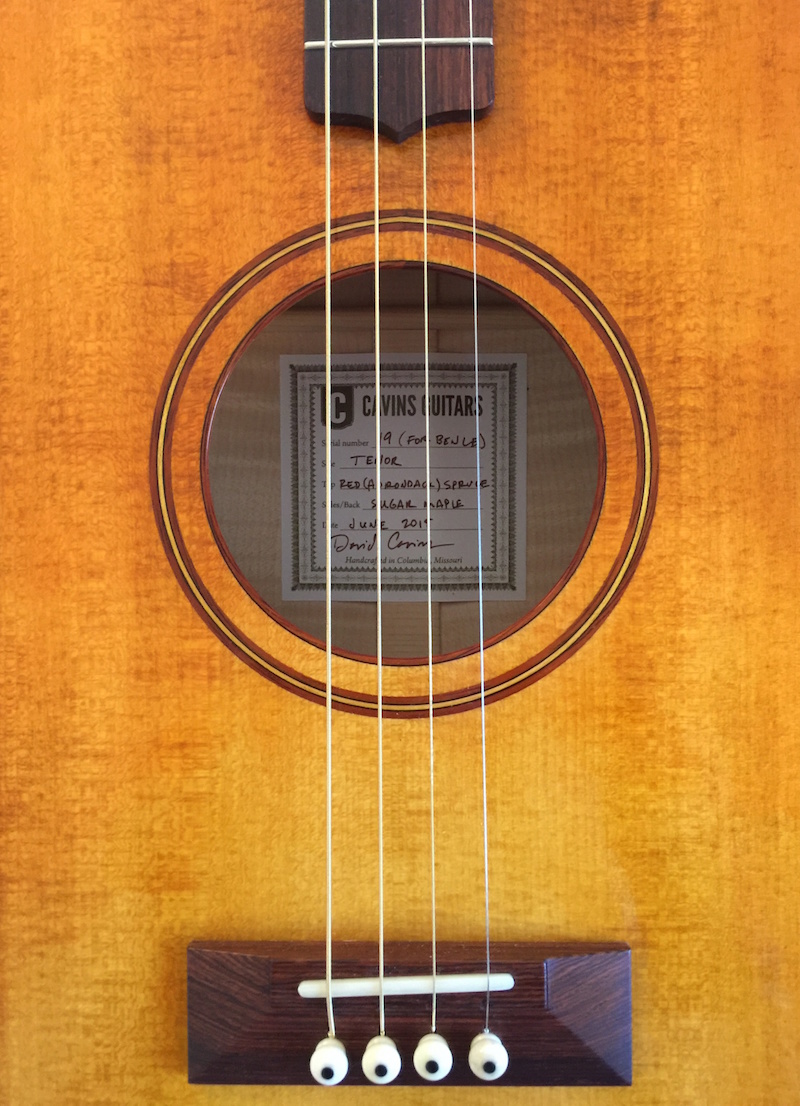
A couple of years ago I reconnected with my college friend and luthier David Cavins, who is based in Columbia, Missouri. David builds beautiful guitars, and although I'm pretty much flush with 6-string acoustics, his tenor guitars piqued my interest. In particular, I wanted to expand my sonic palette while also challenge myself with new tunings beyond 6-string guitar, banjo, and the other instruments I've been fortunate to find across the years. I have a mandolin and although I'm a proficient rhythm player, playing breaks never quite clicked for me. I figured a tenor guitar would give me a comfortable way (as a guitar player) to get more familiar with mandolin-family tunings, while also adding some diversity to our weekly jams (so many guitar and banjo players!). So at the end of last year David started designing a tenor guitar for me.
I previously have posted about the design and build process (see the series of six posts here: 1, 2, 3, 4, 5, and 6), which includes lots of pictures that David send me along the way. Essentially, we each blogged the process in parallel from our perspectives. To briefly review, David's tenors are inspired by a Gibson TG-0 rather than the Martin 0-18T popularized by the Kingston Trio. My guitar is 13" across the lower bout and 3.688" in depth at the endpin, with a scale length of 22.875" and nut width of 1.25". We settled on flamed sugar maple for the back, sides, and neck, with an adirondack spruce top. The binding and other decorative bits are primarily hormigo, and the fretboard and bridge are Honduran rosewood. This guitar has a couple of other unique features, including two subtle "wave " inlays around the perimeter of the back, the strikingly brilliant sunburst shading under the French polished finish, and David's newly-designed adjustable neck joint (see more details about the neck on David's site at the bottom of this page and mid-way down this page).
I received the tenor from David last week and am absolutely blown away by its beauty, and more importantly, by the tone of this instrument. Describing a guitar's tonal qualities is always difficult, especially when I haven't actually played any other tenors and thus don't have a reference point. So I'll just simply say that I can't imagine a tenor sounding any better than this one! At some point I'll try to get around to posting some sound clips, but for now you'll just have to enjoy these pictures.
A couple things I've learned from this process:
1) Working with a luthier on a custom built guitar is a very fun and satisfying experience.
2) David is an extremely talented craftsman, artist, and musician, in addition to being just about the nicest guy you'll ever meet (although I've know this last point since we first met in 1994). If you're looking for a tenor guitar, or auditorium, orchestra, or concert-sized guitar, working with David can't be beat. The balance of tradition, innovation, and responsible choices of sustainable materials in his instruments hits the spot for me, and the design of my tenor guitar is executed into a beautiful sounding, looking, and feeling instrument.
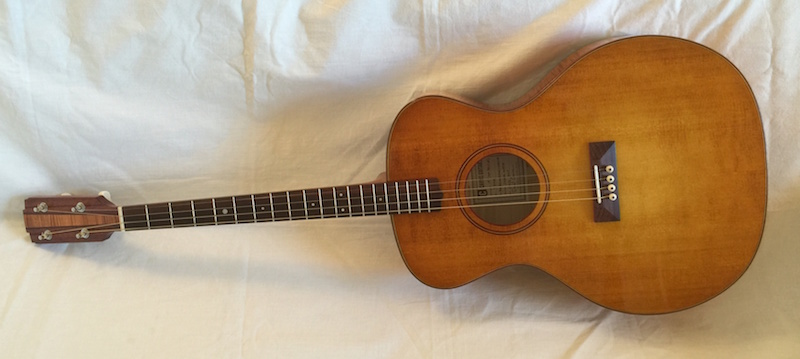
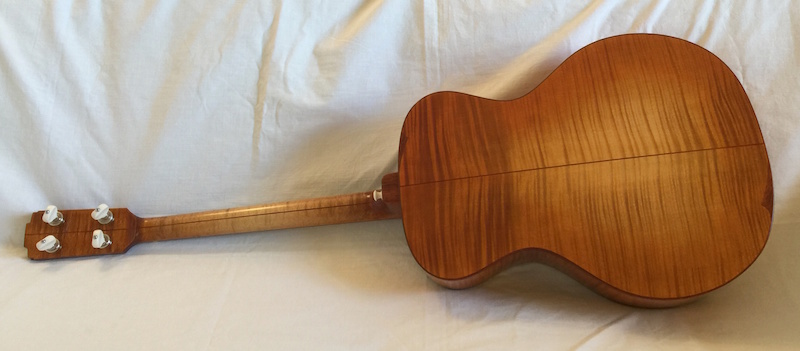
Cavins tenor guitar - Part 6: The shaded finish
This is Part 6 of my series chronicling design, construction, and eventual delivery of a tenor guitar built by David Cavins. See Parts 1, 2, 3, 4, and 5 of this series.
David just posted pictures of the sunburst finish he applied to the tenor guitar; check them out on his blog here. Whoa nelly, that's a fine looking guitar!
Although it's not shown in the pictures below, the bridge has been glued down, and next it will be time for the hardware and set up. It's getting close!
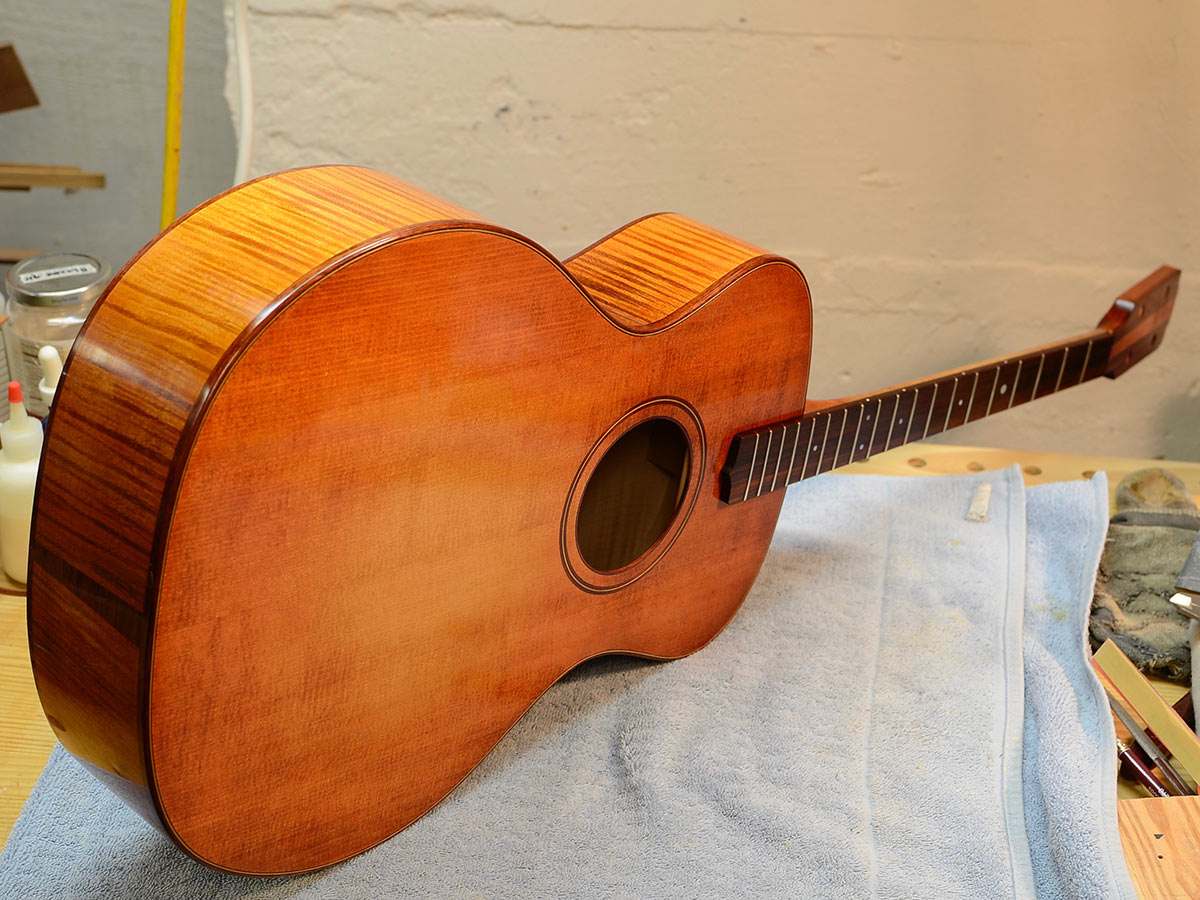

 Wednesday, November 25, 2015 |
Wednesday, November 25, 2015 |  Post a Comment | tagged
Post a Comment | tagged  david cavins,
david cavins,  guitar,
guitar,  lutherie,
lutherie,  sunburst,
sunburst,  tenor guitar
tenor guitar Photo of the week - November 24, 2015
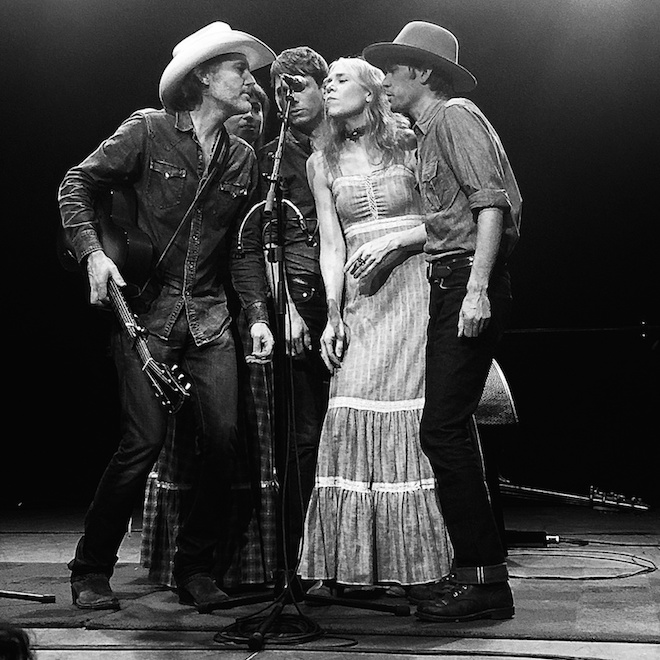
Dave Rawlings Machine @ Union Transfer in Philadelphia, November 17 2015.
 Tuesday, November 24, 2015 |
Tuesday, November 24, 2015 |  Post a Comment in
Post a Comment in  photo of the week | tagged
photo of the week | tagged  dave rawlings machine,
dave rawlings machine,  david rawlings,
david rawlings,  gillian welch,
gillian welch,  iphone,
iphone,  union transfer
union transfer An acoustic oddity - The Rickenbacker 730S Shiloh
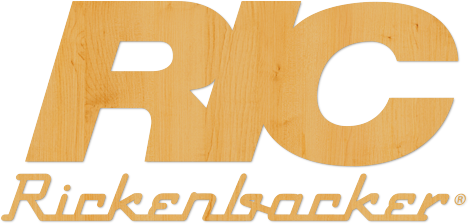 Prelude, part 1 - When I was in college in the mid-90s, all I wanted was a Rickenbacker electric guitar. While most 20-year old guys have pin-ups of women in bikinis in their room, I had a picture of a blonde Rickenbacker 381 on my wall. By the late-90s I was fortunate to be able to get a Rickenbacker 360 (see here), but gradually moved away from playing electric guitar and found the 1-5/8" nut width to be too small, so it moved on to a new home. However, as a fan of the Beatles, the Byrds, Tom Petty, Susanna Hoffs, and the Who, I've always had a soft spot for Rickenbackers.
Prelude, part 1 - When I was in college in the mid-90s, all I wanted was a Rickenbacker electric guitar. While most 20-year old guys have pin-ups of women in bikinis in their room, I had a picture of a blonde Rickenbacker 381 on my wall. By the late-90s I was fortunate to be able to get a Rickenbacker 360 (see here), but gradually moved away from playing electric guitar and found the 1-5/8" nut width to be too small, so it moved on to a new home. However, as a fan of the Beatles, the Byrds, Tom Petty, Susanna Hoffs, and the Who, I've always had a soft spot for Rickenbackers.
Prelude, part 2 - I love mahogany guitars; my main players the last few years have been a Collings D1ASB and some various Martin D-18s (see here, here, and here). I tend to prefer mahogany guitars to rosewood, but over the last few months, the latest bout of GAS had me thinking about rosewood guitars as a way of rounding out my tonal palette. Something with a bit more bottom end than my other guitars, without getting tubby (like some rosewood Martins, at least to my ear). Given my taste for nice Martins and boutique instruments, I spent way too much time browsing at the usual rosewood suspects online: various flavors of new and vintage Martin D-28s, Collings D2Hs, Santa Cruz D/PWs and Tony Rice models, and similar offerings from Huss & Dalton and Dana Bourgeois. Sadly there aren't many good guitar shops in my neck of the woods, so I had resigned myself to waiting for the next time we took a roadtrip or taking a flyer on an online puchase.
* * * * *
Today was the semi-annual Philadelphia guitar show. I usually go to a least one of shows each year, but until last year I had never purchased anything there. This year there were some particular interesting guitars, including a 1947 D-28 (with a refinished back; $8.5k), a 1961 D-21 (~$6k), a 1947 Gibson J-50 ($6.5k), a 1950 J-50 (refinished back; could have been purchased for under $4k), a 1995 custom Martin HD-28S (i.e., 12-fret; didn't ask, but it should have been in the $2-2.5k range), a Gibson Jackson Browne model (i.e., a Roy Smeck-style guitar; $4.1k), a Collings 0002HBaaSB (or some such acronym; a 12-fret 000 with a sunburst sitka top and nice Brazilian rosewood back and sides; $6.8k), a 1953 Martin D-18 (I lusted for this same guitar last time I was at the show, but at $10k it's out of reach and not that much nicer than my '56 D-18), and a Weissenborn Style 4 Hawaiian guitar from the late-1920s ($4k). Other than the Martin HD-28S, most of these are out of my league at this point, so after wandering around the show for a couple of hours I decided to make one more loop around the hall before leaving.
I usually don't pay much attention to the booths that are primarily stocked with electric guitars, but there is usually a vender that specializes in Rickenbackers at the show, and given my affinity for them, I usually at least walk by. I was about to head home when I saw one of my guitar unicorns (i.e., super-cool, but pretty much don't exist): a Rickenbacker acoustic guitar. WTF? Rickenbacker makes acoustic guitars?
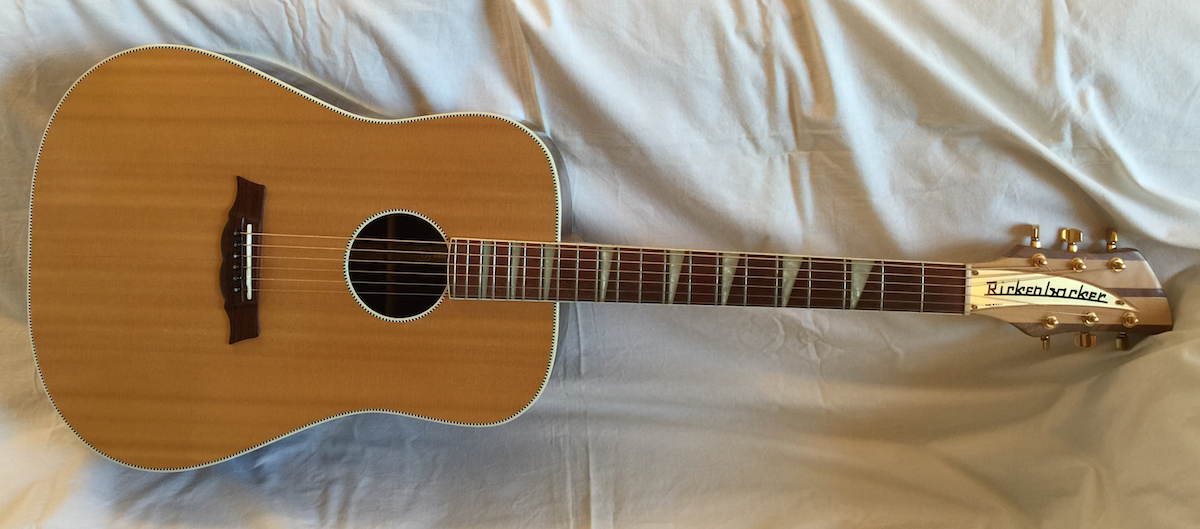
I've vaguely known about these Rickenbacker acoustics for years, but have never seen one in the flesh. And I always figured that (a) they wouldn't sound that good (at least compared to the Martins and Collings that this guitar snob tends to prefer), and (b) that the necks would be too small (they are spec-ed with a 1-5/8" neck like their electric siblings). But how often do you get the chance to play a Rickenbacker acoustic guitar? So I asked if I could take a strum...
It's a Rickenbacker 730S Shiloh, dating from November 2000; a dreadnought with a sitka spruce top and Indian rosewood back/sides, a maple and walnut laminated neck with a rosewood fretboard bound in white and sporting the classic pearloid "shark fin" inlays (very similar, in fact, to my departed 360), with gold Schaller tuners on the traditional Rick-shaped headstock, a rosewood bridge, and white binding with a classy black/white checkered purfling around the body and soundhole. It just oozes with cool.
Holy hell! This thing is an absolute cannon! But the floor of guitar show is always uber-loud thanks to all the wankers cranking up amps (yes, I did hear more than one asshat playing the intro to Stairway today) and I couldn't get a good sense of the tone of the guitar other than sensing that it didn't suck. So I offer to leave my drivers license with the seller so he'll let me take the guitar to a back room that is tucked away adjacent to the men's restroom, where at least it's a bit quieter.
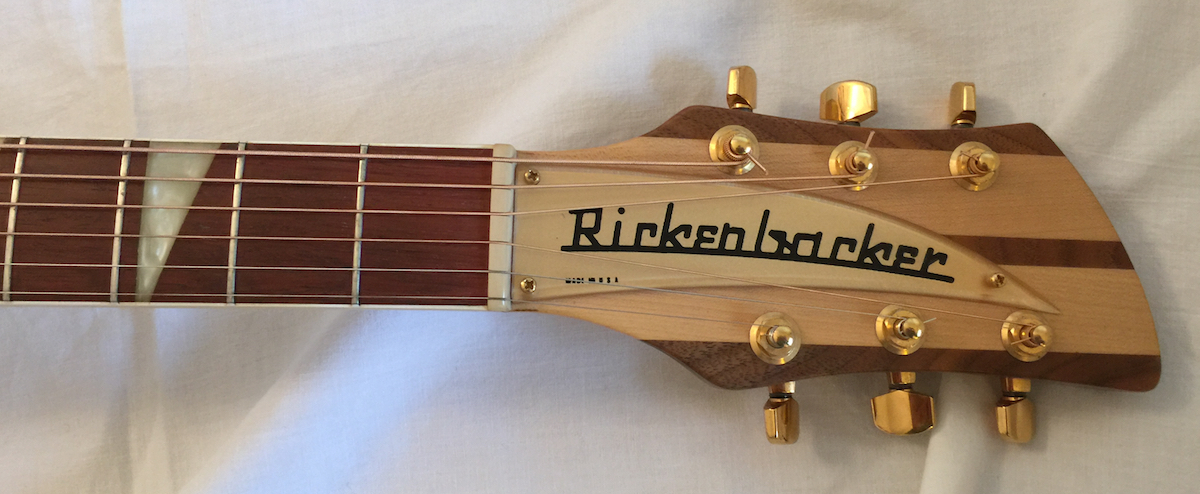
First, the neck doesn't feel tiny in my hands. I prefer 1-3/4" necks usually, and can live with some 1-11/16" necks like the one on my '56 D-18. But I can't believe that I'm finding this 1-5/8" neck to be very comfortable. How can that be? My hand doesn't deceive; the Rickenbacker actually measures at 45mm, which is a smidge over 1-3/4" (yes, this geek carries a small ruler, along with a kit of flat- and fingerpicks, capos, a bar for playing lap steel, and a tuner, when going to the guitar show). So much for the specs on the Rickenbacker page which shows a 1-5/8" neck (the specs also show a 25" in scale, but this guitar measures 25-5/16"). The frets are low and flat, like (surprise) an electric guitar, which takes a bit of adjustment.
Photo of the week - November 17, 2015

At the Tate Modern in London. Fuji X-Pro1 with 14mm lens.
 Tuesday, November 17, 2015 |
Tuesday, November 17, 2015 |  Post a Comment in
Post a Comment in  photo of the week | tagged
photo of the week | tagged  14mm,
14mm,  fuji x-pro1,
fuji x-pro1,  london,
london,  tate modern
tate modern Photo of the week - November 10, 2015

Tourists checking out the Rosetta Stone at the British Museum. Fuji X-Pro1 with 35mm lens.
 Tuesday, November 10, 2015 |
Tuesday, November 10, 2015 |  Post a Comment in
Post a Comment in  photo of the week | tagged
photo of the week | tagged  35mm 1.4,
35mm 1.4,  british museum,
british museum,  fuji x-pro1,
fuji x-pro1,  london,
london,  rosetta stone
rosetta stone Photo of the week - September 1, 2015
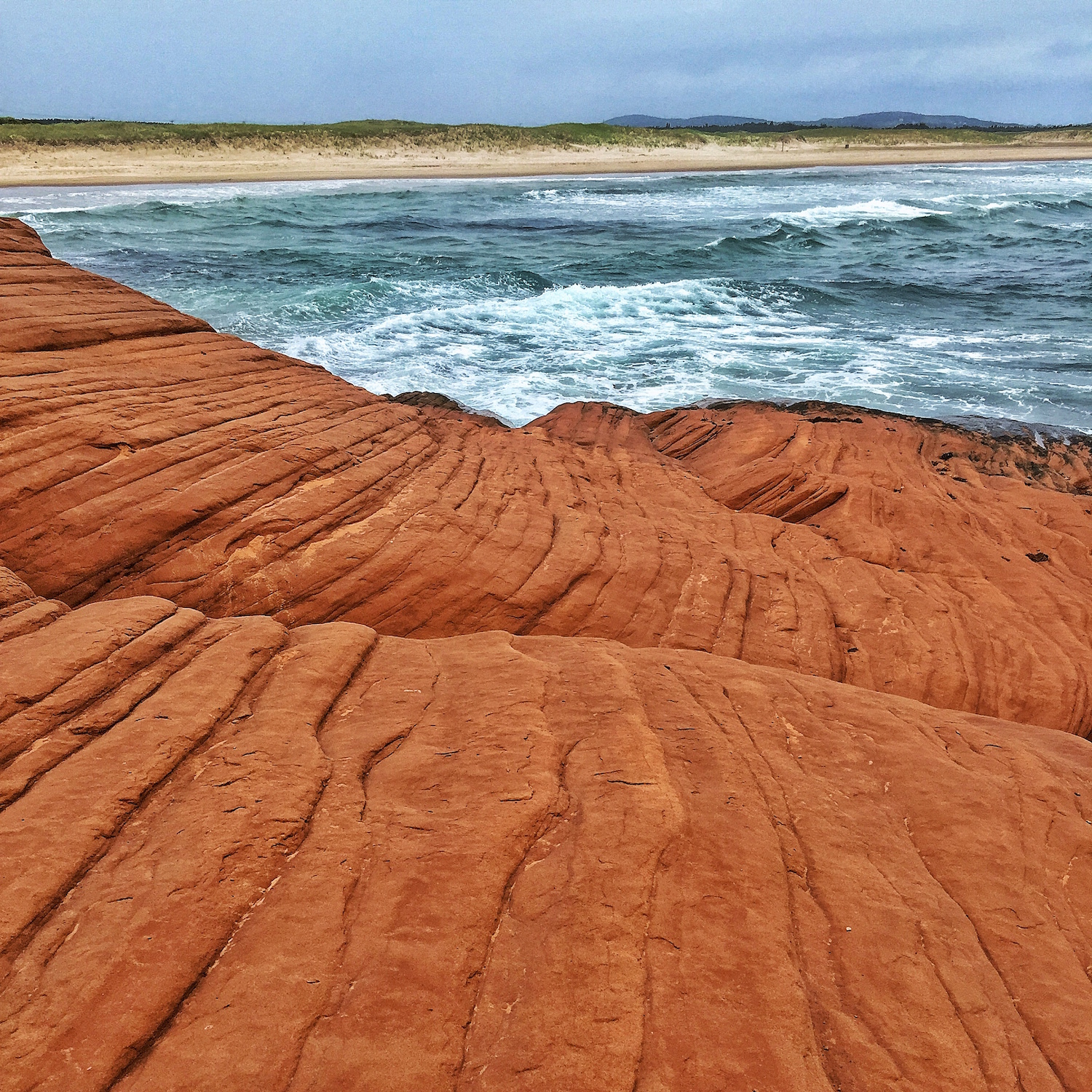
Old Harry, Îles de la Madeleine, Quebec, Canada. iPhone 6+.
 Tuesday, September 1, 2015 |
Tuesday, September 1, 2015 |  Post a Comment in
Post a Comment in  photo of the week | tagged
photo of the week | tagged  canada,
canada,  iphone,
iphone,  magdalen islands,
magdalen islands,  quebec,
quebec,  îles de la madeleine
îles de la madeleine Plugging in with Fishman
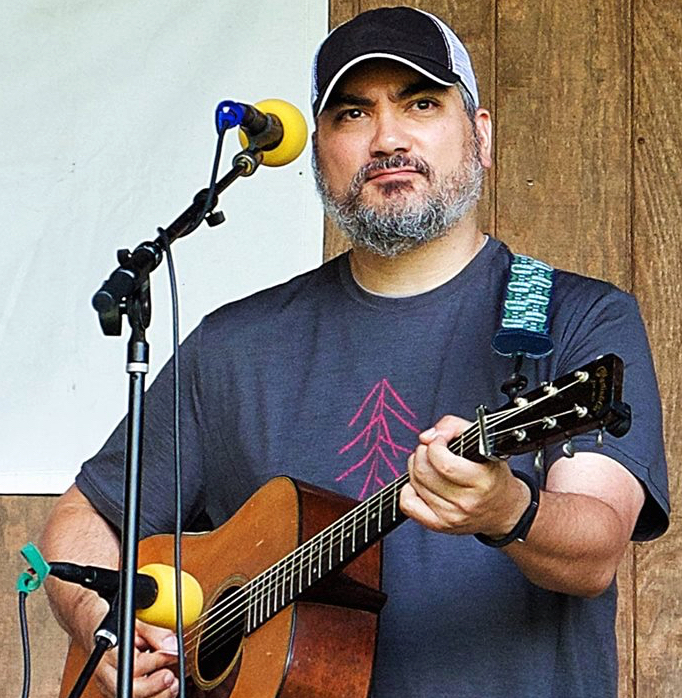 How I usually feel about the way sound guys mic my guitar.I haven't touched an electric guitar in years, but recently have become interested in learning about acoustic amplification. The goals are to be able to:
How I usually feel about the way sound guys mic my guitar.I haven't touched an electric guitar in years, but recently have become interested in learning about acoustic amplification. The goals are to be able to:
1) ...plug in when getting on stage for impromtu sets at bluegrass festivals. I'm tired of having to rely on sound guys dialing-in the instrument microphones. They never seem to get the signal hot enough (which is understandable, given the issues with feedback and that they don't have much time to get things set up between sets).
2) ...have a second channel/option when I'm playing out with our band(s). Typically I've used an instrument microphone (Shure SM81) which has worked fine, but having an additional option for more volume while reducing feedback would be nice.
3) ...mess around with this stuff at home, both to (a) get to know the equipment and dial the sound in before heading out to play live, but also to (b) reinforce the sound a bit at jams. So in addition to getting a guitar pickup, I'll need a small acoustic amp.
After spending way too much time researching online, here's what I ended up getting:
Pickup
I decided the best option was a soundhole pickup so I could potentially swap it between several guitars without too much fuss, and ended up selecting a Fishman Blackstack magnetic pickup ($250). These are supposedly a modern take on the classic Sunrise pickup that some of my favorite artists play (e.g., Lyle Lovett, Richard Thompson), and what I like about the Blackstack is that it can be disconnected from its cable and moved between guitars for different mounting strategies with minimal fuss. The Blackstack comes with a 10' cable that can be run out of the soundhole and connected to a standard guitar cable for a "temporary" installation. But Fishman also sells a 22" cable and endpin jack for a more permanent installation ($40). I installed this shorter cable/jack in my Collings CJ, which previously had a pickup so the endpin was already drilled for a jack. When I want to plug in a different guitar, I'll disconnect the Blackstack from the cable in the CJ (which takes a couple of minutes with nimble fingers and a small screwdriver), connect it to 10' cable, and temporarily mount it in another guitar.
Note: I also considered the Baggs M1, M1A, and M80, and Schertler Magnetico AG6, which are similarly swappable between guitars, but ultimately chose the Blackstack due to its similarity to the classic Sunrise pickup. To be fair, the Sunrise system can also be set up to be swappable, but I likely would have needed a guitar tech to do the wiring. With the Blackstack I was able to do it myself in less than 15 minutes.

Preamp
Since the Blackstack is a passive pickup and doesn't have any controls, a preamp is a good idea, and I ended up choosing the Fishman Platinum Pro EQ.
 Wednesday, August 26, 2015 |
Wednesday, August 26, 2015 |  Post a Comment | tagged
Post a Comment | tagged  acoustic amp,
acoustic amp,  aer,
aer,  baggs,
baggs,  blackstack,
blackstack,  fishman,
fishman,  guitar,
guitar,  loudbox,
loudbox,  pickup,
pickup,  platinum pro eq,
platinum pro eq,  preamp,
preamp,  schertler,
schertler,  sound reinforcement
sound reinforcement 
